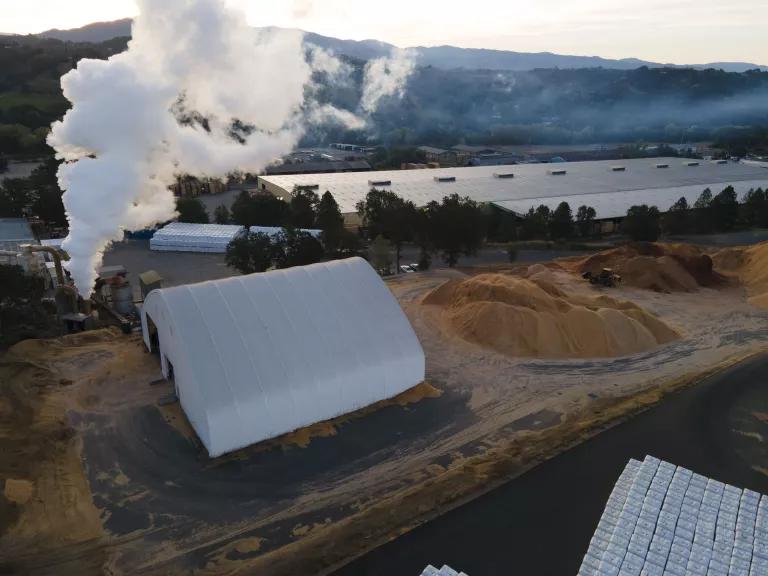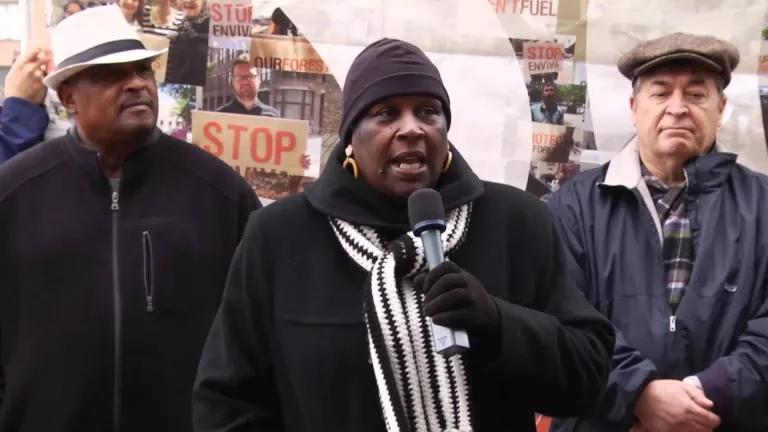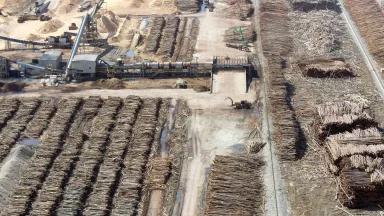Golden State Natural Resources’ Biomass Boondoggle
Community leaders, environmental groups, and residents oppose greenwashed biomass production and export scheme in California.

Golden State Natural Resources estimates its biomass production facilities will need nearly 2 million green tons of trees every year. The 100-mile radius of its sourcing range includes the Stanislaus National Forest, above.
James Bentley/Dreamstime
Golden State Natural Resources’ (GSNR) proposed wood pellet project threatens to create ongoing logging demand in California forests and spread the biomass industry’s harmful legacy—all too familiar in the Southeast—into local communities.
If approved, two GSNR facilities would be built in Tuolumne and Lassen counties and produce up to one million tons of wood pellets every year for export to global markets in Europe and Asia. There, they would be burned in industrial power plants to produce electricity.
GSNR maintains that its project will help to protect California’s forests and benefit rural communities—as well as combat climate change—but the science and past experience with similar projects elsewhere in the United States and in Canada show this is simply not true.
Cutting down trees and burning them to make electricity degrades critical forest carbon sinks and emits as much carbon as fossil fuels. Furthermore, wood pellet production facilities emit toxic air pollution that harms public health and are often sited in communities of color and low-income communities, exacerbating existing environmental injustice.
GSNR’s proposal for two industrial-scale wood pellet facilities is new for California, but a tale told many times in the rural southern United States, which has suffered from this industry.
Greenwashed claims of forest preservation
Burning wood pellets for electricity is not a “carbon-neutral” climate solution. These facilities would require nearly 2,000,000 green tons annually to create those wood pellets, and GSNR has stated it will source from timber operations on 40,000 acres each year.

This Calpella, California, biomass production plant produces about 35,000 tons of wood pellets every year—just a fraction of the one million tons to be exported from GSNR’s proposed facilities.
Juan Meija
GSNR claims that it will only use salvage wood and unmerchantable trees. But, given the new facilities’ production goals, this is likely impossible. In reviewing its marketing materials and project notice, we found that GSNR actually proposes to cut and remove trees of any type and size within a 100-mile radius of each pellet facility, all under the category of “roundwood.”
Industry made the same greenwashed claims in the Southeast. Years of ground-truthing have found that the wood pellet production industry is taking whole, big trees, oftentimes from mature hardwood forests—and no amount of certification can guarantee there are any safeguards to only use waste. In fact, a feasibility study for GSNR’s project conducted in 2020 assumed roughly 80 percent of the wood used to make pellets would come from “green” whole trees and chips. And GSNR’s plans for the pellet facilities include equipment for debarking and grinding up whole logs, not just chipped forest waste.
False guise of economic development
Finally, this entire debacle is a poor use of public funds that could be spent for economic development that does not exacerbate climate change or worsen public health. Both GSNR and the lead agency on the California Environmental Quality Act process—Golden State Finance Authority (GSFA)—are affiliated with the Rural County Representatives of California, which aims to serve the interest of rural counties, including economic development. GSFA is a public joint powers agency composed of county representatives, while GSNR purports to be a private nonprofit corporation. Disturbingly, GSFA is also GSNR’s principal funder, having issued the company a $10 million loan in June 2020. GSNR has also sought and received grants from the U.S. Forest Service.
Again, we’ve seen this song and dance in the U.S. Southeast. While the wood pellet production industry has repeatedly arrived in environmental justice communities—from North Carolina to Louisiana—with promises of economic improvement, this hasn’t occurred. In Northampton County, North Carolina, for example, poverty rates actually increased since the Enviva-owned wood pellet plant began operating there. Community leaders, like Belinda Joyner in Northampton County, have organized tirelessly to bring attention to the onslaught of harms that wood pellet production facilities bring to their communities, highlighting the increased truck traffic on small roads, dangerous air pollution, dust, constant noise, and a degraded forest landscape.
Time and again, the industry has promoted the purported job benefits (often inflated, based on potential multiplier effects) and neglected the economic impact of adverse health effects that come with exposure to wood dust, fine particle pollution, volatile organic compounds, and hazardous air pollutants.

Belinda Joyner of Northampton County, North Carolina, speaks to a crowd gathered in protest against a biomass export terminal in Chesapeake, Virginia, in November 2014.
Dogwood Alliance
Real threats to local communities
In a scoping hearing held in mid-June, it was stated that GSNR will be seeking a Title V permit, which would allow it to emit more than 100 tons of air pollutants annually. Tuolumne County, slated for GSNR’s wood pellet production facility, already has a higher-than-average pollution burden, high rates of asthma and cardiovascular disease, and a high poverty rate. Tuolumne County’s costs per asthma hospitalization are higher than the state average. This is a serious economic impact, but not the one that GSNR is advertising.
The trucks and other transportation needed to transport wood to the pellet mills and, subsequently, the pellets to the Port of Stockton, GSNR’s proposed export point, will cause even more air pollution. Even with California’s forthcoming landmark clean trucks and clean vehicle rules, communities could face increased air pollution for years to come. These emissions include nitrogen dioxide, which is linked to cardiovascular disease, asthma, and other respiratory ailments, and which satellite research suggests impacts low-income communities of color at far greater rates than wealthier white counterparts.
The community surrounding the Port of Stockton already faces some of the highest pollution burdens in the state, including high exposure to particulate matter. Stockton residents are greatly concerned that the project would exacerbate issues they are already facing. As communities in the southern United States have called out, the permitting process has served as a mere checkbox exercise for many years now. We know from partners’ experiences in the Southeast the harms that these facilities can cause. GSNR’s claims of economic development and climate resiliency must not be accepted as excuses to perpetuate environmental injustice in vulnerable communities.
Civil society organizations have strongly come out against the project not once but twice, and now the local communities that stand to be impacted are calling out the project’s justification as hollow at best. The climate crisis requires us to value standing forests for the carbon they sequester and store. Communities that face overwhelming pollution burdens deserve better than more of the same. GSNR’s stated goals may sound lofty and ideal, but they actually pose an imminent threat to our climate, biodiversity, and communities, and they are nothing more than another biomass boondoggle.







